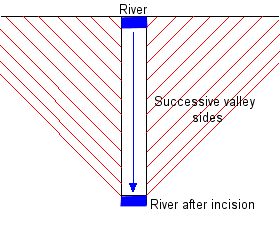Formation of a V shaped valley.
Please start at Evolution.html
Conditions:
(a) Channelised flow starts on a rock surface.
(b) The rock is resistant and strong enough to support a vertical slope.
(c) River incision (down cutting) is rapid and at a constant rate.
(d) The valley sides are subject to slow weathering at a constant rate.
(e) The weathering detaches material from the valley side that falls into the river below.
(f) The river is able to remove all the weathered material.
Explanation of the simulation:
(a) The river is shown in blue and the rock in green.
(b) The rock is divided up into rectangles to represent the fragments it weathers to. The angle of rest of the weathered material is given by the diagonal of the rectangle. The dimensions of the rectangles can be varied to give the angle of rest required.
(c) Each click on the manual simulation represents a constant unit of time.
(d) The incision is shown in stages.
(e) At each stage it is assumed a layer of rock of uniform width is weathered and removed by free fall. This assumption is, of course, a simplification. In reality a wedge, wider at the top, than the bottom would be weathered and removed. The inaccuracy explains the unrealistic stepped profiles. However if these are smoothed out the gradient of the valley side is accurate.
(f) The method of rectangles is used because it will allow us to see how the valley sides flatten in the next simulation.
The diagram below shows how a steep sided V-shaped valley is formed and develops:

The valley gets deeper and deeper and wider and wider with the valley sides remaining at a constant angle. This is very unlikely to occur for any length of time. Although the development of a V-shaped valley increases the efficiency of runoff and may increase the volume of the river the amount of work the river has to do at each stage increases. The amount of weathered debris that has to be removed increases as the sides lengthen. Eventually, too, the gradient of the river is going to decrease.
It is very doubtful that most V-shaped valleys are formed under these conditions.
|
